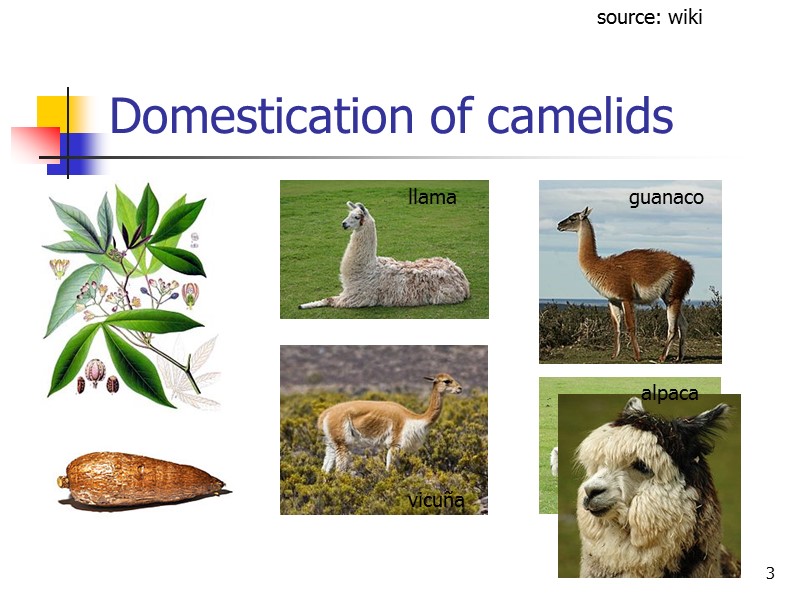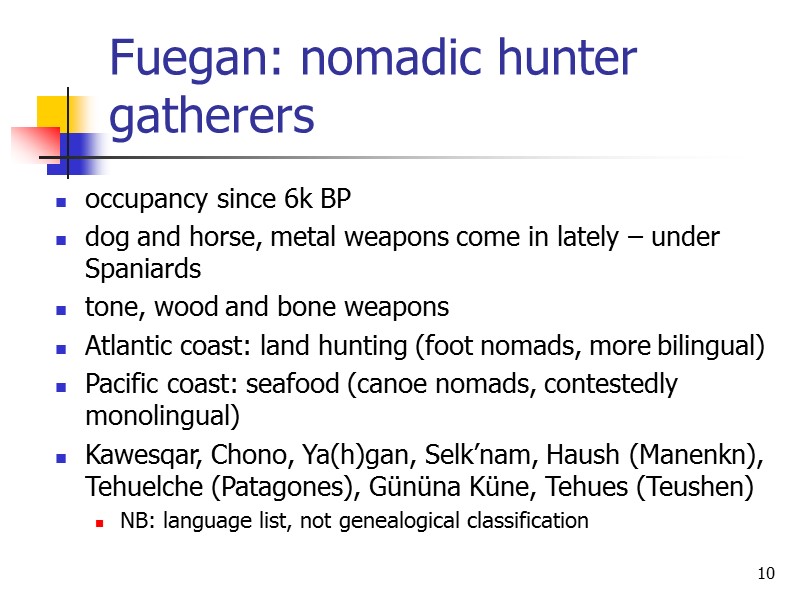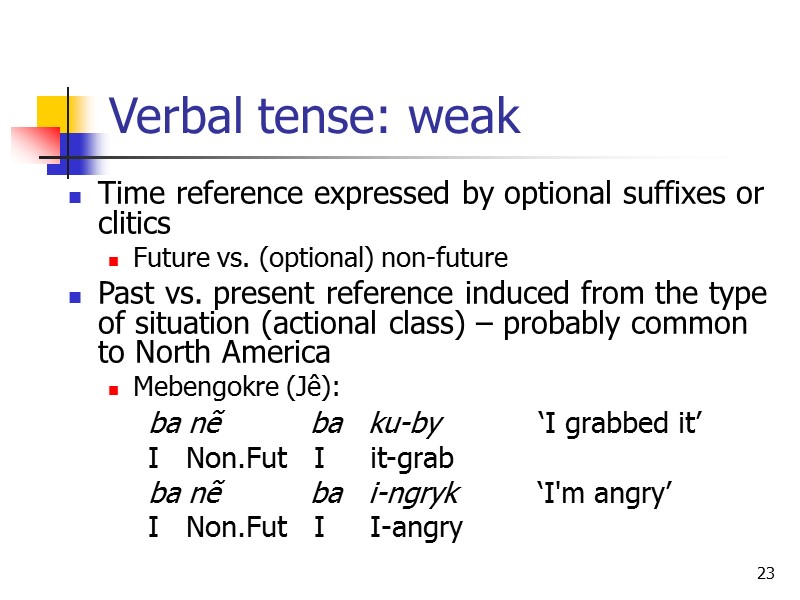Languages of South America. Amazonian Languages After Epps


































31808-07-south_america._amazonia.ppt
- Количество слайдов: 33
 Languages of South America. Amazonian Languages After Epps & Salanova 2013 (typology of Amazonian), Adelaar 2004 (the Andes) (unless otherwise indicated, maps come from glottolog.org and Adelaar 2004) Никогда вы не найдете В наших северных лесах Длиннохвостых ягуаров Броненосных черепах
Languages of South America. Amazonian Languages After Epps & Salanova 2013 (typology of Amazonian), Adelaar 2004 (the Andes) (unless otherwise indicated, maps come from glottolog.org and Adelaar 2004) Никогда вы не найдете В наших северных лесах Длиннохвостых ягуаров Броненосных черепах
 2 Generalities: South America https://en.wikipedia.org/wiki/Settlement_of_the_Americas simonsoutherton.blogspot.ru Short vs. long chronological theory All settlers coming to the Americas after 19k BP (LGM) vs. First setlers coming before LGM, i.e. 21 to 40 k BP First evidence of humans in South America back in 11k BP Evidence of manioc cultivated from 4k BP in Amazon Basin, agrarian communities in the Andes 5,5k BP – domestication of llamas, vicuñas, guanacos, and alpacas
2 Generalities: South America https://en.wikipedia.org/wiki/Settlement_of_the_Americas simonsoutherton.blogspot.ru Short vs. long chronological theory All settlers coming to the Americas after 19k BP (LGM) vs. First setlers coming before LGM, i.e. 21 to 40 k BP First evidence of humans in South America back in 11k BP Evidence of manioc cultivated from 4k BP in Amazon Basin, agrarian communities in the Andes 5,5k BP – domestication of llamas, vicuñas, guanacos, and alpacas
 3 Domestication of camelids alpaca llama vicuña guanaco source: wiki
3 Domestication of camelids alpaca llama vicuña guanaco source: wiki
 4 South America Languages of the Andes: grue Amazonian languages: orange
4 South America Languages of the Andes: grue Amazonian languages: orange
 5 Adelaar 2004: the five ‘spheres’ Chibcha sphere Chibchan (27) pouring out to Mesoamerica Inca sphere Languages of the eastern slopes Araucanian sphere Tierra del Fuego
5 Adelaar 2004: the five ‘spheres’ Chibcha sphere Chibchan (27) pouring out to Mesoamerica Inca sphere Languages of the eastern slopes Araucanian sphere Tierra del Fuego
 6 Adelaar 2004: the five ‘spheres’ Chibcha sphere Inca sphere Quechuan (45) Languages of the eastern slopes Araucanian sphere Tierra del Fuego
6 Adelaar 2004: the five ‘spheres’ Chibcha sphere Inca sphere Quechuan (45) Languages of the eastern slopes Araucanian sphere Tierra del Fuego
 7 Adelaar 2004: the five ‘spheres’ Chibcha sphere Inca sphere Languages of the eastern slopes (111) Tacanan (7), Jivaroan (4), Cahuapanan (3), Bora-Huitoto (9), Zaparoan (6) and isolates Also Panoan, Arawakan, Tupi-Guarani, Tucanoan, Araucanian sphere Tierra del Fuego
7 Adelaar 2004: the five ‘spheres’ Chibcha sphere Inca sphere Languages of the eastern slopes (111) Tacanan (7), Jivaroan (4), Cahuapanan (3), Bora-Huitoto (9), Zaparoan (6) and isolates Also Panoan, Arawakan, Tupi-Guarani, Tucanoan, Araucanian sphere Tierra del Fuego
 8 Adelaar 2004: the five ‘spheres’ Chibcha sphere Inca sphere Languages of the eastern slopes Araucanian sphere (2) Tierra del Fuego
8 Adelaar 2004: the five ‘spheres’ Chibcha sphere Inca sphere Languages of the eastern slopes Araucanian sphere (2) Tierra del Fuego
 9 Adelaar 2004: the five ‘spheres’ Chibcha sphere Inca sphere Languages of the eastern slopes Araucanian sphere Tierra del Fuego 1 (†8)
9 Adelaar 2004: the five ‘spheres’ Chibcha sphere Inca sphere Languages of the eastern slopes Araucanian sphere Tierra del Fuego 1 (†8)
 10 Fuegan: nomadic hunter gatherers occupancy since 6k BP dog and horse, metal weapons come in lately – under Spaniards tone, wood and bone weapons Atlantic coast: land hunting (foot nomads, more bilingual) Pacific coast: seafood (canoe nomads, contestedly monolingual) Kawesqar, Chono, Ya(h)gan, Selk’nam, Haush (Manenkn), Tehuelche (Patagones), Gününa Küne, Tehues (Teushen) NB: language list, not genealogical classification
10 Fuegan: nomadic hunter gatherers occupancy since 6k BP dog and horse, metal weapons come in lately – under Spaniards tone, wood and bone weapons Atlantic coast: land hunting (foot nomads, more bilingual) Pacific coast: seafood (canoe nomads, contestedly monolingual) Kawesqar, Chono, Ya(h)gan, Selk’nam, Haush (Manenkn), Tehuelche (Patagones), Gününa Küne, Tehues (Teushen) NB: language list, not genealogical classification
 11 Contact conditions: mixed marriages, particularly in the late colonial period; barter between the Selk’nam on one side and the Yahgan or Kawesqar on the other; slaving raids (e.g. by the Chono in Kawesqar territory); shared fishing grounds (e.g. between the Kawesqar and the Yahgan); capture of Kawesqar women by the Tehuelche; migration of groups of Selk’nam across the Strait of Magellan and integration of the latter into the Tehuelche, migration of Tehuelches across the Strait of Magellan; extensive migration of Mapuche Indians into Patagonia.
11 Contact conditions: mixed marriages, particularly in the late colonial period; barter between the Selk’nam on one side and the Yahgan or Kawesqar on the other; slaving raids (e.g. by the Chono in Kawesqar territory); shared fishing grounds (e.g. between the Kawesqar and the Yahgan); capture of Kawesqar women by the Tehuelche; migration of groups of Selk’nam across the Strait of Magellan and integration of the latter into the Tehuelche, migration of Tehuelches across the Strait of Magellan; extensive migration of Mapuche Indians into Patagonia.
 12 Language loss in Tierra del Fuego “false precision”; contagious deseases as well as armed colonization in 19th cent.
12 Language loss in Tierra del Fuego “false precision”; contagious deseases as well as armed colonization in 19th cent.
 13 Classification: unresolved Languages of land nomads - Selk'nam, Haush, Gününa Yajich, Teushen and Tehuelche – probably related (10 to 55 percent of basic vocabulary) Kawesqar + Chono +? Yahgan
13 Classification: unresolved Languages of land nomads - Selk'nam, Haush, Gününa Yajich, Teushen and Tehuelche – probably related (10 to 55 percent of basic vocabulary) Kawesqar + Chono +? Yahgan
 14 Phonology Voiced, glottalized present but not widespread, complex syllables E.g. Selk’nam: ejectives, r~l variation
14 Phonology Voiced, glottalized present but not widespread, complex syllables E.g. Selk’nam: ejectives, r~l variation
 15 Morphology
15 Morphology
 16 Word order xe-nn mer čonn ‘The man came’ come-AF.MS DC man yEpr t’E:n han t’elqn ‘The girl usually eats meat’ meat eat CU girl (Najlis 1973 via Adelaar 2004)
16 Word order xe-nn mer čonn ‘The man came’ come-AF.MS DC man yEpr t’E:n han t’elqn ‘The girl usually eats meat’ meat eat CU girl (Najlis 1973 via Adelaar 2004)
 17 Amazonia: ~300 lgs in ~ 50 gen. units Map shows major families only, including: Tupi-Guarani 76 Arawakan 60 Carib 32 Panoan 27 Tuk(c)anoan 25 Jê 16 Brazil, but also Venezuela, Bolivia, Peru, Columbia, Paraguay http://www.athenapub.com green purple blue
17 Amazonia: ~300 lgs in ~ 50 gen. units Map shows major families only, including: Tupi-Guarani 76 Arawakan 60 Carib 32 Panoan 27 Tuk(c)anoan 25 Jê 16 Brazil, but also Venezuela, Bolivia, Peru, Columbia, Paraguay http://www.athenapub.com green purple blue
 18 Language families and isolates Tupi(-Guarani) – 76 incl. Guarani, official lg of Paraguay, some 5 mln speakers Carib – 32 (incl. Carib, Hixkaryána, Macushi, Apalaí) Panoan 27 (incl. Shipibo-Konibo) Tukanoan 25 Arawakan (Maipurean) – 60 (incl Paumari) Jê 16 Putative Macro Jê includes in addition Bororo (2), Jabutian (2), Maxakalian (2), isolates Krenak, Ofaye, Karaja, Rikbatsa Minor families: Nadahup (Puinavean) - 7 (incl. Hup), Arauan 6, Nambiquaran 6, Chapacuran 5, Guaykuruan 5, Yanomam 4, Katukinan 2, Yaguan 2 Isolate: Pirahã (“Pirahã debate”), Trumai…
18 Language families and isolates Tupi(-Guarani) – 76 incl. Guarani, official lg of Paraguay, some 5 mln speakers Carib – 32 (incl. Carib, Hixkaryána, Macushi, Apalaí) Panoan 27 (incl. Shipibo-Konibo) Tukanoan 25 Arawakan (Maipurean) – 60 (incl Paumari) Jê 16 Putative Macro Jê includes in addition Bororo (2), Jabutian (2), Maxakalian (2), isolates Krenak, Ofaye, Karaja, Rikbatsa Minor families: Nadahup (Puinavean) - 7 (incl. Hup), Arauan 6, Nambiquaran 6, Chapacuran 5, Guaykuruan 5, Yanomam 4, Katukinan 2, Yaguan 2 Isolate: Pirahã (“Pirahã debate”), Trumai…
 19 Phonetic and phonology Rare phonemes: bilabial affricate (Shipibo), bilabial trill (Wari’, Pirahã) voiced linguolabial double flap (tongue tip hits the roof of the mouth then the bottom lip) Pirahã Lexical tone: register tone (low, high, none), sometimes limited to the stressed syllable (pitch accent?) Nasal prosody, nasal harmony Guarani nasal harmony nõ-rõ-nũpã-ĩ ‘I don't beat you’ ndo-ro-haihu-i ‘I don't love you’
19 Phonetic and phonology Rare phonemes: bilabial affricate (Shipibo), bilabial trill (Wari’, Pirahã) voiced linguolabial double flap (tongue tip hits the roof of the mouth then the bottom lip) Pirahã Lexical tone: register tone (low, high, none), sometimes limited to the stressed syllable (pitch accent?) Nasal prosody, nasal harmony Guarani nasal harmony nõ-rõ-nũpã-ĩ ‘I don't beat you’ ndo-ro-haihu-i ‘I don't love you’
 20 Noun classes: rich Sex-based gender systems Classifiers Some Bora lgs: several hundred classifiers Humans by sex, animates by sex, shape or unspecified, inanimates by shape, function etc. Shape: flat, round, long etc.; culture based classifications Wakú ‘vines, snakes, fishing lines’ + ‘large catfish’?? large catfish is the namesake of a ceremonial trumpet that is bound with a vine rim and named ‘two-snakes.’
20 Noun classes: rich Sex-based gender systems Classifiers Some Bora lgs: several hundred classifiers Humans by sex, animates by sex, shape or unspecified, inanimates by shape, function etc. Shape: flat, round, long etc.; culture based classifications Wakú ‘vines, snakes, fishing lines’ + ‘large catfish’?? large catfish is the namesake of a ceremonial trumpet that is bound with a vine rim and named ‘two-snakes.’
 21 Numeral systems: poor Some ‘1’ and ‘2’ only; many ‘1’ to ‘3’ to ‘5’ Often, etymologically transparent: in Hup, ‘two’ derives from ‘eyes’, ‘three’ from ‘rubber tree seed’. In many ‘four’ derives from ‘brother, companion’ Andersen 2005: “where numeral systems exist, they are a cultural attainment, that is, they have developed (or been borrowed from other languages) because they were culturally motivated.”
21 Numeral systems: poor Some ‘1’ and ‘2’ only; many ‘1’ to ‘3’ to ‘5’ Often, etymologically transparent: in Hup, ‘two’ derives from ‘eyes’, ‘three’ from ‘rubber tree seed’. In many ‘four’ derives from ‘brother, companion’ Andersen 2005: “where numeral systems exist, they are a cultural attainment, that is, they have developed (or been borrowed from other languages) because they were culturally motivated.”
 22 Tense and number Tense Number Nouns Verbs How come?
22 Tense and number Tense Number Nouns Verbs How come?
 23 Verbal tense: weak Time reference expressed by optional suffixes or clitics Future vs. (optional) non-future Past vs. present reference induced from the type of situation (actional class) – probably common to North America Mebengokre (Jê): ba nẽ ba ku-by ‘I grabbed it’ I Non.Fut I it-grab ba nẽ ba i-ngryk ‘I'm angry’ I Non.Fut I I-angry
23 Verbal tense: weak Time reference expressed by optional suffixes or clitics Future vs. (optional) non-future Past vs. present reference induced from the type of situation (actional class) – probably common to North America Mebengokre (Jê): ba nẽ ba ku-by ‘I grabbed it’ I Non.Fut I it-grab ba nẽ ba i-ngryk ‘I'm angry’ I Non.Fut I I-angry
 24 Tensed nouns Arawak, Carib, Nambiquara, Tupi-Guarani: tensed nominal reference a. che-roga-kue my-house-FORMER ‘my former house’ (ashes or house) b. che-roga-ra my-house-FUTURE ‘my future house’ (bricks or standing house)
24 Tensed nouns Arawak, Carib, Nambiquara, Tupi-Guarani: tensed nominal reference a. che-roga-kue my-house-FORMER ‘my former house’ (ashes or house) b. che-roga-ra my-house-FUTURE ‘my future house’ (bricks or standing house)
 25 Tensed nouns Not verbal tense cliticized to nouns! Epps: “… structurally simple noun phrases with markers that encode the evidence surrounding the epistemic status of the entity's existence.” Independent of clausal verbal tense: a. o-va-ta che-róga-kue-pe 3-move-FUT 1-house-FORMER-in ‘He will move into my former house.’ b. a-va-va'ekue hoga-rã-pe 1-move-PAST 3.house-FUTURE-in ‘I have moved into his future house.’
25 Tensed nouns Not verbal tense cliticized to nouns! Epps: “… structurally simple noun phrases with markers that encode the evidence surrounding the epistemic status of the entity's existence.” Independent of clausal verbal tense: a. o-va-ta che-róga-kue-pe 3-move-FUT 1-house-FORMER-in ‘He will move into my former house.’ b. a-va-va'ekue hoga-rã-pe 1-move-PAST 3.house-FUTURE-in ‘I have moved into his future house.’
 26 Verbal number Multiple participants (agreement?) or multiple event (iterativity)? Itonama – complicate verbal number but lacking nominal number Possibly a trait in common with N. America, esp. Muskogean and Tsimshian, where it is morphologically similar to Jê
26 Verbal number Multiple participants (agreement?) or multiple event (iterativity)? Itonama – complicate verbal number but lacking nominal number Possibly a trait in common with N. America, esp. Muskogean and Tsimshian, where it is morphologically similar to Jê
 27 Verbal number Mẽbengokre, alias Kayapo (Jê): argument number shifts to aspect when the verb changes from dynamic to stative (nominalized) form a. krwỳj jã nẽ môp krẽ ‘This parakeet ate the malanga.’ parakeet this NFUT malanga eat.V.SG b. krwỳj jã nẽ môp ku ‘…ate the malangas.’ parakeet this NFUT malanga eat.V.PL a. krwỳj jã nẽ kute môp krẽn ‘…has eaten (once in his life).’ parakeet this NFUT 3ERG malanga eat.N.SG b. krwỳj jã nẽ kute môp kur ‘…often eats’ parakeet this NFUT 3ERG malanga eat.N.PL
27 Verbal number Mẽbengokre, alias Kayapo (Jê): argument number shifts to aspect when the verb changes from dynamic to stative (nominalized) form a. krwỳj jã nẽ môp krẽ ‘This parakeet ate the malanga.’ parakeet this NFUT malanga eat.V.SG b. krwỳj jã nẽ môp ku ‘…ate the malangas.’ parakeet this NFUT malanga eat.V.PL a. krwỳj jã nẽ kute môp krẽn ‘…has eaten (once in his life).’ parakeet this NFUT 3ERG malanga eat.N.SG b. krwỳj jã nẽ kute môp kur ‘…often eats’ parakeet this NFUT 3ERG malanga eat.N.PL
 28 Evidentiality: abundant Nonvisual (heard, but also tasted or felt) Visual may be marked but usually unmarked Reportative Does quotative count? Inferred Speaker’s responsibility for ‘facticity’ of the information conveyed or for the event itself connection to culture: interactive expectations and ethnography of speech
28 Evidentiality: abundant Nonvisual (heard, but also tasted or felt) Visual may be marked but usually unmarked Reportative Does quotative count? Inferred Speaker’s responsibility for ‘facticity’ of the information conveyed or for the event itself connection to culture: interactive expectations and ethnography of speech
 29 Evidentiality: abundant Interaction with grammar and morphology From obligatory to discourse-based Visual may be marked but usually unmarked From particles to paradimgs of suffixes to fusion with tense, person and number (Tuyuca < East Tukano)
29 Evidentiality: abundant Interaction with grammar and morphology From obligatory to discourse-based Visual may be marked but usually unmarked From particles to paradimgs of suffixes to fusion with tense, person and number (Tuyuca < East Tukano)
 30 Ergative alignment: many Carib, Arawak, Tupi, (Macro) Jê, Nadahup, Panoan, Zaparo, Yagua, Yanomami, Trumai, Tacana, Guahibo Ergativity: ‘counter’-splits: Ergative on pronouns, accusative on NPs Ergative in present (generic / habitual), accusative with past reference
30 Ergative alignment: many Carib, Arawak, Tupi, (Macro) Jê, Nadahup, Panoan, Zaparo, Yagua, Yanomami, Trumai, Tacana, Guahibo Ergativity: ‘counter’-splits: Ergative on pronouns, accusative on NPs Ergative in present (generic / habitual), accusative with past reference
 31 Active alignment: Tupi Alias: split intranstive, active-stative, split S, fluid S Especially Tupi-Guarani in common with N. America? A P A P A reason to introduce the fourth slot to Dixonian A/S/P opposition? Need to distinguish between S=A and S=P?
31 Active alignment: Tupi Alias: split intranstive, active-stative, split S, fluid S Especially Tupi-Guarani in common with N. America? A P A P A reason to introduce the fourth slot to Dixonian A/S/P opposition? Need to distinguish between S=A and S=P?
 32 Active alignment: Tupi Alias: split intranstive, active-stative, split S, fluid S Especially Tupi-Guarani A S P Rather, distinction is based on verbal classification: stative vs. active Stative may exhibit nominal properties The same verb may be construed with active and stative interpretation
32 Active alignment: Tupi Alias: split intranstive, active-stative, split S, fluid S Especially Tupi-Guarani A S P Rather, distinction is based on verbal classification: stative vs. active Stative may exhibit nominal properties The same verb may be construed with active and stative interpretation
 33 Active alignment: Tupi Guarani:
33 Active alignment: Tupi Guarani:

